wire rope cable slings factory

Unlike synthetic or fiber slings, wire rope offers increased resistance to wear and abrasion and can be used for both hot and cold materials as well as in corrosive applications such as those in marine, construction, aerospace, manufacturing, assembly, transport, shipping, and other industries where wire rope slings are commonly used. Wire ropes fitted with slings in these applications also serve to improve connectivity and prevent fraying of the rope.
Like stranded wire ropes, the slings that they attach too are strictly regulated and must be inspected regularly as mechanical failure puts both machinery and employees at serious risk. To prevent such disruptions, it is important to select the proper sling for a given application.
Slings are most commonly constructed simply by looping or folding the end of a wire rope back onto itself and holding it in place with a firm fitting such as a clamp. Alternatively, the folded segment of wire may be braided or twisted along the main body of rope and otherwise held in place through welding or similar processes.
The rope itself is comprised of cold drawn filaments that are twisted or braided into strands which in turn are helically wrapped around a core. The multilayered formation of wire rope acts as a safety measure as individual strands are more likely to fail than the rope as a whole, allowing the other strands to act as a backup.
Popular materials for wire rope and sling construction include aluminum, nickel alloy, bronze, copper, and titanium, although steel and stainless steel are the most common due to their increased strength and availability.
Additional considerations include the wire rope sling"s dimensions, fatigue strength, its ability to bend without distortion, to withstand abrasion, and environmental conditions as well as the intended use for the sling.
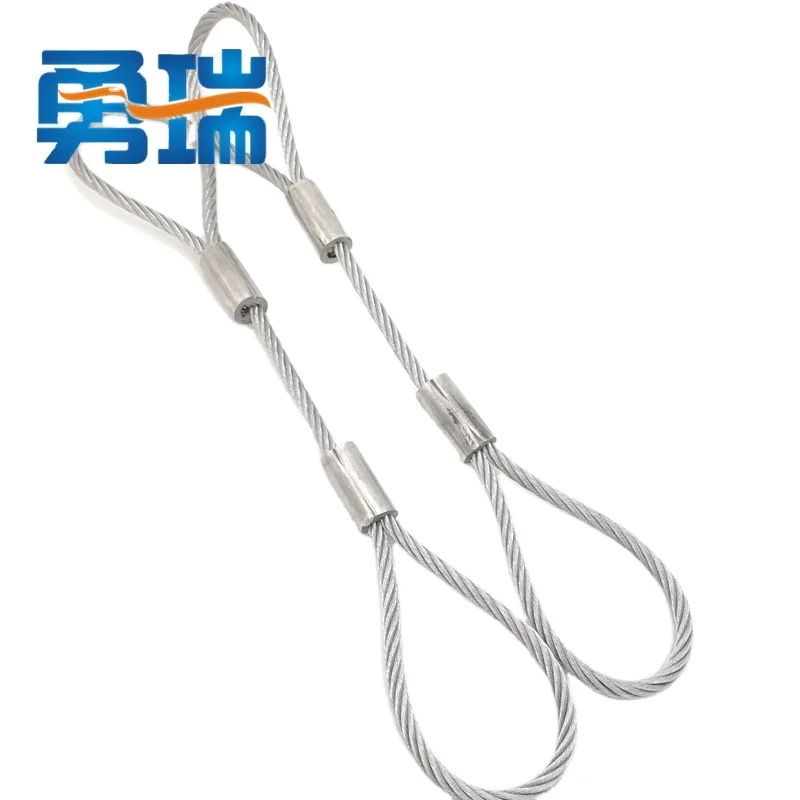
Wire rope slings are extremely strong and an excellent choice for heavy duty jobs involving not only lifting, but also hoisting, towing, or anchoring loads. The fabrication of wire slings also offers excellent abrasion-resistance and heat resistance so it can be used in extreme conditions and temperatures. Its pliable design can conform to the shape of a load for a more secure application.
Wire rope slings are manufactured in a variety of configurations, with 6x19 and 6x36, being two of the most common. The numbers represent the number of wires making up the strand and the number of strands wrapped around the core. For example, a 6x19 indicates that there are 19 wires making up a strand, and 6 strands are wrapped around the core.
Each steel wire rope configuration will offer different benefits and will be better suited to certain applications. In general, a smaller number of large outer wires offers better wear and corrosion resistance, while a larger number of small wires provides a better level of flexibility and fatigue resistance.
We offer steel wire rope slings in both 6x19 and 6x36 configurations, depending on the diameter of the wire rope. All are in a bright (unfinished) wire rope, but other configurations are available by request. Our cable laid slings are manufactured in a 7x7x7 galvanized wire rope (composed of 7 strands of 7x7 cables), which make them extremely flexible and useful for more specialized applications.
The eye loops on our sling cable are created with a Flemish splice, which is a mechanical splice where the rope cable is separated into two parts (one part has three strands, the other part has the remaining three strands plus the core), then re-laid back in the opposite direction to form the loop. The ends are then secured with a carbon steel sleeve around the entire area. Flemish splices offer the most efficient use of capacity.
The core of the wire rope used in cable slings can be made of several different materials, including steel or natural fibers. Our steel wire rope slings are made with Extra Improved Plowed Steel (EIPS) around an Independent Wire Rope Core (IWRC) for the ultimate in strength and durability.
Our categories of wire rope slings are broken down by number of legs, hardware, and the diameter of the wire rope. Each wire sling is made to order, so custom slings are also always an option if you don"t see what you"re looking for here.
We offer a wide selection of both domestic wire rope slings and import wire rope slings online, with additional options and customization available by calling our sales team.
Import slings are a more cost-effective choice yet offer the same wire rope strength and working load limits as our domestic slings. Our imported slings also feature sleeve components from Crosby. Wire rope slings we import are also available in custom configurations.
Sometimes called eye & eye slings because of an oval "eye" at each end, these 1 leg cable slings are rugged and reliable and a very popular choice among wire slings. The eyes are formed using a Flemish eye splice and secured with a carbon steel sleeve.
Single leg cable slings are available in a variety of styles: Eye & Thimble, Thimble & Thimble, Eye & Hook, Eye & Eye, Sliding Choker, and Cable Laid.
Also known as a 2 leg bridle sling, this sling offers increased versatility over a sling with just a single leg. Manufactured with a Flemish eye that"s spliced with a carbon steel sleeve; end options range from a latched eye hook to a simple eye design. Our 2 leg wire rope slings are available in seven different diameters of rope. Custom options are also an option.
Our 3 leg wire rope slings are also known in the industry as a 3 leg bridle sling. Each is manufactured with a Flemish eye that"s spliced with a carbon steel sleeve for the ultimate in safety and strength. End options include latched eye hooks, eyes equipped with thimbles, and more, as customized options are always available. Our 3 leg wire rope slings are available in seven different diameters of rope.
A 4 leg bridle sling offers the ultimate in versatility. Also known in the industry as wire rope 4 leg bridle slings, ours are manufactured with a Flemish eye that"s spliced with a carbon steel sleeve for an extra measure of security. And because legs can be fitted with hardware of your choosing, from simple eye formations to heavy duty hooks, it results in a sling customized to your exact application needs. Our 4 leg wire rope slings are available in six different diameters of rope.
Braided wire rope slings are formed when multiple wire ropes are braided continuously to form the body of the sling and the eye/eyes into a single fabricated sling. Braided wire slings are excellent for higher capacity lifts and can be either round or flat. One benefit of a braided sling is its ability to conform snugly to a load that"s in a choker hitch. Because of the braided design, they also are better resistant to kinking.
Our braided wire rope slings are made in the USA and available in a variety of configurations, including a 3-part braid, 6-part braid, 8-part braid, and 9-part braid. Several style options are also available, including standard eyes, thimble eyes, and more, to create a customized braided wire rope sling to your specifications.
Wire rope bridles are measured by the length of the sling leg plus the end hook. The length of the oblong master should not be included in the overall measurement.
Our slings are available in a variety of lengths, but can also be customized to any length you need. Give our sales team a call for more information or to place a custom order.
"Slings in contact with edges, corners, protrusions, or abrasive surfaces shall be protected with a material of sufficient strength, thickness, and construction to prevent damage."- ASME B30.9 (2021) 9-5.10.4(d)
All of our slings are inspected, certified and tagged with metal tags displaying rated capacities by hitch types and angles; diameter or size; and name/trademark of the manufacturer.
Proof testing certificates can be supplied with your order for a nominal fee and must be requested at the time of order. Proof tests are performed in the factory where the sling is pull tested to 2x the vertical rating and officially recorded as proof for governing bodies. During the standard manufacturing process, only random slings during a production run are tested for compliance; in order to provide proof testing certificates with your order, every sling must be pull tested at the time of manufacture.
If steel wire rope slings are not the best choice for your application, we also offer chain slings, nylon lifting slings, and polyester round slings in a wide range of styles and capacities. As with all of our lifting slings, customization is always an option.
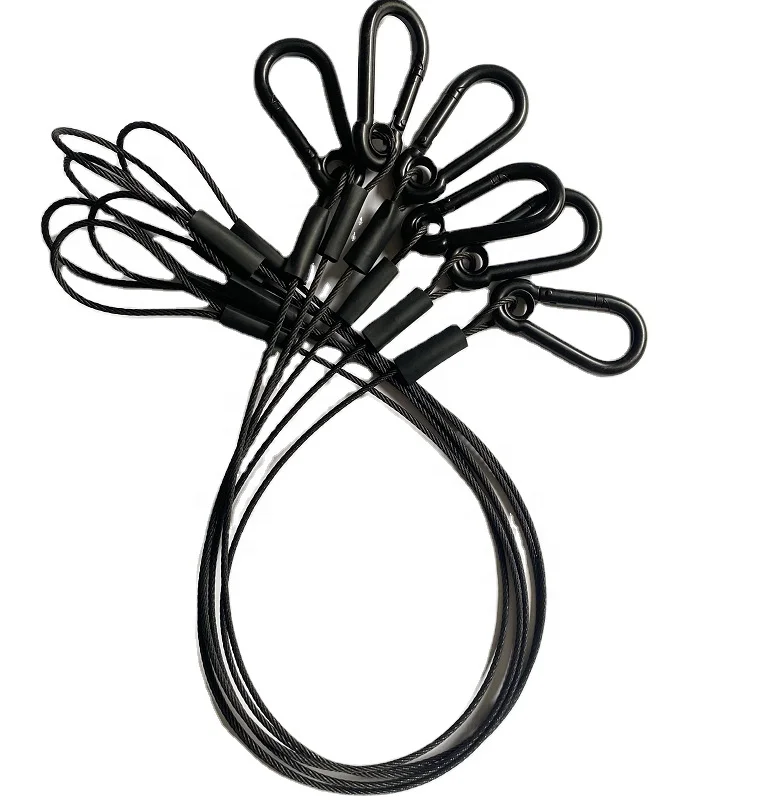
Wire rope slings have been used extensively for years and were once the industrial lifting sling of choice. Wire rope slings, sometimes referred to as wire cable slings are more robust and durable than nylon slings and also have higher temperature limits.
Wire rope slings with an independent wire rope core (IWRC) can withstand contact and exposure temperatures up to 400 degrees (F). Wire cable slings with fiber cores should never be exposed to temperatures in excess of 180 degrees (F). Wire rope slings of all types should never be used at temperatures below -40 degrees (F). Wire rope rigging slings with fiber cores (FC) are rated at reduced capacities when compared with an equivalent size, wire choker with an independent wire rope core (IWRC). They are generally fabricated from 6 x 19 or 6 x 37 construction wire cable. The constructional numbers refer to the number of strands (6) that are helically wound around a core. The core supports the strands of the wire rope lifting sling and can either be an independent wire rope core (IWRC) or a fiber core (FC) made from hemp or sisal. Smaller diameter wire rope slings feature 6 strands with 19 wires in each strand. Larger diameter industrial lifting slings will generally feature 6 strands with 37 individual wires in each strand. The 6 x 37 construction is more flexible than the 6 x 19 construction, but not as abrasion resistant.
Wire cable lifting slings used by the crane, rigging and material handling industries are available in many different styles and constructions to meet your needs. Custom made slings and special order slings are shipped daily from our factory. The most popular wire lifting slings are Single Body slings featuring a 6 x 19 or 6 x 37 Construction, Extra Improved Plow Steel (EIPS) Wire Rope with an Independent Wire Rope Core (IWRC). These slings are sometimes referred to as wire chokers, Permaloc wire rope slings, wire cable slings, Flemish eye slings, single leg slings, eye and eye slings or eye & eye slings due to the loop or eye that is formed on each end of the wire sling.
There are different grades and strengths of steel used to manufacture the individual wires that make up the sling. The most popular for sling fabrication is (EIPS). Metallurgists continue to improve the tensile properties of steel with new, corresponding designations such as EEIPS (Extra-Extra Improved Plow Steel). Single leg, Flemish Eye/Mechanical Splice, Wire Slings provide additional security, superior to return loop wire slings should the swage sleeve become damaged during use. Single Body Wire Cable slings are available in 15 different types which feature different combinations of plain loops, three types of thimbles (crescent, standard and slip through) and rigging hooks. Thimbles greatly improve sling longevity by protecting the rope at connection points. We offer two types of single leg wire slings that feature a sliding choker hook that is placed between the sling eyes. Industrial lifting slings with sliding choker hooks make removal of the cable sling from the load, quick and easy. Type 14 lifting slings feature a lifting loop on one end and a thimble on the opposite end to engage the sliding choker hook. Type 15 lifting slings features plain loops each end. View the 15 single leg wire sling types available .
We will not sell you a sliding choker hook without a hook latch, but there are many that will! Stainless Steel Wire Rope Slings provide the sling user with improved corrosion resistance and are also readily available. Cable Laid Wire Rope Slings with a galvanized finish are also available. Cable Laid Wire Slings are much more flexible than equivalent sized, single body wire slings. The flexibility of industrial lifting slings that feature a cable laid construction is a direct result of the small diameter, aircraft cable used in the fabrication of the wire sling. Size for size, cable laid lifting slings are not as strong as equivalent sized, single body, wire chokers. Cable laid wire slings can be equipped with many of the same options available for single body slings.
In addition to our standard lifting slings, custom made slings are also readily available. Cable laid slings are also referred to as Ultra flexible cable laid slings, steel strand and E-Z Flex Cable Laid wire rope slings. Wire Rope Bridle Slings are available in two leg bridle, three leg bridle and four leg bridle designs. A master link is used to collect the multiple wire cable sling legs, while providing a connection point to the hoist line. Bottom “connectors” such as masterlinks or eye hoist hooks (with latches) are most commonly used to engage the load. Custom made bridle slings are also readily available.
In addition to wire bridles we also offer a complete line of strand laid grommets and swaged socket assemblies. Slingmax® Wire Rope Slings are as revolutionary to wire cable slings as Twin-Path® Extra, high performance fiber slings are to polyester roundslings. That makes sense, because both products are patented inventions from the mind of Dennis St. Germain, Sr. Without a doubt, Mr. St. Germain has done more for the sling, crane and rigging industries than any other. It all started years ago with the Tri-Flex® Sling which provides professional riggers with a great combination of strength and flexibility. Tri-Flex® wire rope slings provide substantial savings due to the materials used and the tremendous labor savings realized in the fabrication process. Tri-Flex® cable slings were also the genesis of T&D Ultra-Flex® slings which are used extensively in the power generation, transmission and distribution industries.
Gator-Laid® wire rope slings and Gator-Max® wire cable slings are the most efficient, heavy lift slings available. Both the Gator-Laid® wire slings and Gator-Max® lifting slings feature 12 parts of wire in the sling eye and meet all the requirements of the Wire Rope Technical Board and the United States Navy. Gator-Flex® wire rope slings and Gator-Flex® wire rope grommets are heavy lift slings used extensively by the oil and gas industries for both land based and off shore rigging. Gator-Flex® wire slings offer sling users the greatest flexibility available for a heavy lifting sling. Gator-Flex® grommets not only provide flexibility, but can be fabricated for applications requiring minimum sling lengths.
Like all of our nylon web slings and polyester round slings, wire rope slings need to be inspected on a regular basis to ensure the safety of sling users. Poor inspection practices can lead to devastation, injury and death. Please refer to the inspection and usage information that is available in our Rigging Resource Guide or on our web site. Read and understand the warnings that accompany all our products. Remember, ignore a warning leads to much mourning.
All wire chokers shipped from Lift-It have a heavy duty, metal sling tag attached. There is no additional charge for this as we have always felt it is our duty to provide robust sling tags. Others may use cloth or synthetic materials which sometimes come off the sling, before it’s even used! Others fill in the information with magic marker that is not so magic. The tag is just as important as the wire cable, the way the Flemish eye is fabricated and the way the mechanical sleeve is swaged. If a vendor wants to charge you extra for a metal tag, run as fast and as far as you can from them and contact the sling experts at Lift-It Manufacturing, where profit margins are not maximized by supplying labels that should be used on clothing.
While wire cable slings are more robust and durable than nylon lifting slings or polyester roundslings, wire slings are not cut proof. Wire slings need to be protected from damage like all industrial lifting slings. Only materials of sufficient strength, thickness and construction must be used to prevent damage. Do not use gloves or cardboard. Use protection devices that have been designed to resist the effects of cutting and abrasion. Wire Rope Saddle Protectors are readily available; Click Here

Manufacture of material handling gripper slings made from 304 or 316 stainless steel, 4130 heat-treated alloy steel, exotic alloys and neoprene. Features include polyurethane plastic-covers, wire mesh construction, interwoven and tolerate abrasive loads. Suitable for handling all types of products such as coiled strips, thin-walled tubing, polished shafting, lumber, paper machine rolls, precast hollow core concrete beams, structural beams, cold drawn flats and irregularly shaped objects. Serves the marine, automotive, beverage, cement, energy, food and mining industries.
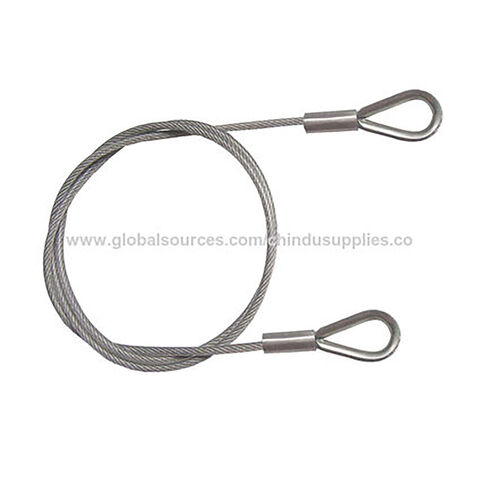
Wire rope is constructed of multiple strands of wire that are twisted and braided together to form a spiral design or helix. Once the separate wires are shaped into a solid form, they become a single wire with greater strength because the individual wires equalize pressure and have greater flexibility than the individual strands.
To further enhance the strength of wire ropes, they are grouped and wound together to produce cables, which adds to their usefulness as a means of support, ability to lift, and give structural stability.
A key factor in wire rope is the lay of the strands, which can be regular or lang. With regular lay, or right and ordinary lay, the strands are wound from left to right with the wires laid in the opposite direction of the lay of the strands. With lang lay, the wires are wound in the same direction.
The structure and design of wire rope produces a final product that has superior strength, excellent strength flexibility, and the ability to handle constant bending stress as well as being weather resistant.
Wire rope is one of those products that has found a place in a wide variety of industries since it can be adapted and shaped to fit several applications. It can be found as a tow cable for boats and airplanes or in the movie industry as a harness for stunt artists. The varied uses of wire rope have made it an essential part of operations that require a rope with strength, endurance, and flexibility.
In the aerospace industry, wire ropes, or Bowden cables, connect pedals and levers in the airplane cockpit to send power to aircraft systems to control the airplane. The things that are controlled by wire ropes are propeller pitch, cowl flaps, and throttle. Wire ropes on aircraft are insulated to avoid vibrations.
Wire rope is extensively used in the auto industry for a wide variety of applications due to its versatility and strength. It is used for raising windows and opening and closing sunroofs. Other uses include steering wheels, cables, exhausts, springs, sunroofs, doors, and seat components. In the manufacturing process, wire rope is used to hoist vehicles, move large body parts, and on hoists and cranes.
The construction industry has a greatest reliance on wire rope because of the need to lift and lower heavy loads. Wire rope used in construction must have extremely high strength and exceptional performance for safety reasons and efficiency. Larger versions of wire rope are used for suspension bridges and supporting concrete columns.
The main use of wire rope in food processing is for lifting, moving loads, and other heavy tasks. Finished products or raw materials require being moved in storage units and processing centers. The strength and endurance of wire rope makes it possible to move these materials. Wire rope for food processing must be able to withstand regular chemical cleaning.
As with other industries, the oil and gas industry needs strong and reliable equipment for moving heavy equipment. In ocean drilling, machinery is dropped into the ocean using wire rope to securely hold devices to be dropped to extreme depths. Wire ropes are designed to withstand the extreme pressure and stress required. A further use of wire ropes for drilling operations is to maintain stability in the drilling lines. One of the unique features of oil rig wire rope is its length, which can exceed 10,000 feet.
A very common use for wire rope is mooring and towing of sea and freshwater boats and vessels. In the shipbuilding industry, wire rope is used to secure lifeboats as well as lower them into the water. On sailboats, wire rope is used to lift and lower sails. The benefit of using wire rope is its resistance to corrosion and rust caused by salt water and ocean mist.
The skiing industry, much like heavy equipment industries, uses wire rope to hold cars, lifts, or chairs to transport skiers up the mountain. This type of wire rope comes in several varieties depending on the size of the mountain. The benefits of wire rope for skiing is its dependability, guaranteed safety, and reliability. The main challenge of wire rope for use in sports is the weather conditions it must endure.
Since the beginnings of amusement parks, wire rope has been an essential part of attraction construction. It is used to bring roller coaster cars to the top of the ride, hold swings, and pull various vehicles through attractions. One of the main concerns of public amusement parks is safety since rides are filled with powerful machinery designed to operate continuously.
Making the dangerous and exciting shots in movies requires well planned safety precautions. One of the aspects of that planning is wire rope that is designed to protect performers when they are engaged in dangerous and life threatening shots. Dependable wire ropes are ideal since they have the flexibility, strength, endurance, and versatility to be adapted to any conditions.
In architecture and design, wire rope has been used for guard rails, balustrades, and roof construction. In innovative green buildings where plants grow along the surface of the building, the plants grow along specially designed vertical wire ropes that are capable of withstanding weather conditions.
A common use of wire rope is in railings, which are safe, durable, and provide a pleasing aesthetic appeal. The use of wire rope for railings provides protection without obstructing the view from a building. This aspect of wire rope is one of the reasons that it is used for large architectural projects since it blends into the structure without interiors with the architectural design.
The types of wire rope are determined by the number of wires in each strand and how many are in the rope, which is defined by a two number system with the first number being the number of wires and the second being the number of wires in each strand. For example, a 6x19 wire rope has 6 wires in 19 strands.
There are a wide variety of products that are produced using wire rope. The demand for wire rope products is due to its strength, durability, and reliability. Since the basic purpose of wire rope is to lift and move heavy materials and items, the most common type of wire rope product is the wire rope sling.
Though the construction of wire rope slings is very similar for all types, there are certain variations applied to slings to adjust them to fit different applications. Slings are configured in various ways to fit different types of loads. These changes are referred to as hitches.
Bridle Hitch: The multiple leg or bridle hitch style has more than one wire rope sling attached to equalize the load and control balance. They reduce load damage by using fixed points on the load and offer easier rigging when hooked into fixed lifting points. .
Single Part Wire Rope Sling: The eye for a single part wire rope sling is formed by looping the wire rope back on to the rope. The end of the rope is attached by a clamp or being woven by hand or mechanically into the rope body. Single part wire rope slings use a single wire rope to produce the sling.
Braided Wire Rope Sling: A braided wire rope sling is made by braiding wire ropes to form a sling. The increased number of strands enhances the strength of the sling and its load capacity. Braiding can be done with three to nine wire ropes.
Cable Laid Wire Rope Sling: Cable laid wire rope slings are made from combining several smaller wire ropes to form a flexible, easy to handle, and kink resistant sling.
Woven Eye Wire Rope Sling: For the woven eye version of a wire rope sling, the eye is formed by weaving the wire rope into itself after forming the loop. It is designed to reduce the chance of the sling catching or being hung up when lifting.
Thimble Wire Rope Sling: To add to the strength of wire rope slings and lessen the stress on a small area of the eye, a thimble, a U shaped piece into which the wire rope fits, is placed in the eye, which helps the sling to retain its natural shape. The thimble is positioned to prevent the hook or load from coming in contact with the wire rope.
Endless Wire Rope Sling:Endless wire rope slings are adaptable slings without a set wear point. They can be manufactured in a wide range of sizes and are used in applications where headroom may be a problem. Endless wire rope slings are made by splicing the ends of a piece of wire rope together or by tucking strand ends into the body to form a core with a tucked position the opposite of the core position. They are also referred to as grommet wire rope slings.
Coiled wire rope is made from bundles of small metal wires that are twisted into a coil. It comes in many varieties and is easy to store since it does not require a spool. Coiled wire rope is produced in coils. When it is not in use, it springs back into a coil, which makes it easy to handle.
Cable wire rope is a type of high strength rope, made of several individual filaments. These filaments are twisted into strands and helically wrapped around a core. One of the most common types of wire rope cable is steel cable.
Push pull wire rope assemblies are used to send force and are used in the aircraft, exercise, medical, automotive, and office equipment industries. Unlike using a single heavy wire, push pull assemblies made with wire rope are stiffer and have a larger bend radii for smoother motion of the wire.
Wire rope assemblies include wire rope and various parts and components that have been added to the wire rope to enhance its function. The connectors for a wire rope assembly are designed to connect the assembly to hooks, equipment, or machines as well as other wire rope assemblies. The central part of a wire rope assembly is the wire rope, which determines the type and kind of work the assembly can perform.
Wire rope lanyards are a standard wire rope product that have a multitude of uses. They are produced using the same process that is used to produce wire rope with the same numbering categorizing system. Lanyards are used to hold fasteners, hardware, or components to prevent loss of an item or prevent injury.
In many ways, wire rope is a form of machine with multiple moving parts. Normally, when we think of a machine, we imagine a device with a motor, drives, and gears. Wire rope does not have any of those components but does fit the definition of being a complex mechanism. It has moving parts that work together to move heavy materials and loads.
The main function of wire rope is to do heavy lifting, which is very dependent on wire rope slings. The type of sling is determined by the quality of the wire rope used to form them and whether several ropes have been braided or wound together.
Wire is the smallest part of wire rope but makes up the various strands. The composition of the wire can be steel, iron, stainless steel, copper, or other types of metal wires and are produced in different grades. The individual wires can be coated or bright, meaning uncoated.
Strands are sets of wires that are twisted together and are placed in a helical pattern around the core. The size of the wire determines its abrasive qualities with larger wires being more abrasive and less flexible than smaller ones.
The core is the center of the wire rope and serves as a support for the strands and helps the wire rope keep its position when it is under stress or bearing a load.
Lubrication is applied during the manufacturing process to reduce friction between the wires and strands as well as protection from corrosion and rust. The tight winding of the wires enhances the ability of the wire rope to retain the lubrication which is essential to its longevity.
The purpose of applying lubricant is to limit the friction between the cables to increase the useful life of the wire rope. In certain applications, such as space travel, lubricants can be hazardous and cause equipment to malfunction. In those instances, non-lubricated wire rope is used, which is referred to as dry wire rope or cable.
Of all of the products that are made from wire rope, slings are the most common and widely used. These looped wire ropes come in different varieties and grades depending on the type of wire used. Also, to enhance wire sling performance, several wire ropes may be wound together to form a sturdier and more reliable sling.
Flemish splicing is a method for repairing a wire rope and involves breaking the wire rope in half and tying it back together. In the Flemish method, the wire rope is tied back on itself and swaged down a sleeve over the unbroken wire rope to create the new eye.
Prior to placing the wire rope into the holding device used to shape the eye, a steel compression sleeve is placed on the rope, which will be used to secure and hold the eye.
Once the proper size is achieved, the unwound strands are rewound in the reverse order of their former positioning. If the wire rope has a right hand lay, it is rewound using a left hand lay. The opposite is true if the wire rope has a left hand lay, then it is rewound using a right hand lay. By using this technique, a friction mold is formed for the splicing of the sling.
Anti-rotational wire rope resists the forces of rotation by having opposing layers of helical stands. By winding the wire rope with oppositional strands, the wire rope is guaranteed to not unwind in clockwise or counterclockwise directions. The key to anti-rotational wire rope is to ensure that the outer diameter is static.
In the manufacture of anti-rotational wire rope, counter stranded filaments have vacant spaces between them. To make the wire rope anti-rotational, it is tightly twisted in the counterclockwise direction, which tightens the spaces between the filaments. If the wire rope is turned in a counterclockwise direction, the strands tighten around each other creating a spring force.
The tails and stray wires of the wire rope have to be straightened and properly formed before applying the compression sleeve. Once the sleeve has been placed, it is carefully checked to be sure that it is accurately engaged.
Prior to placing the wire rope sling in the swaging die, the die has to be thoroughly lubricated. Once the die is set, the wire rope‘s compression sleeve and the wire rope are compressed using several hundred thousand pounds of force. The swaging process alters the dimensions of the wire rope and compression sleeve to form a tight connection for the correct diameter for the sling connection. As force is applied, the compression sleeve is turned so that pressure is evenly applied.
There are several types of metal wires that are used to produce wire rope, which include steel, stainless steel, galvanized, aluminum, nickel alloy, bronze, copper, and titanium. Carbon steel is the most common type of wire rope material.
Wire ropes are made using uncoated bright wire, which is high-carbon steel. The type of steel depends on the requirements of the wire and its tensile strength and its fatigue and wear resistance.
Galvanized wire rope is treated with zinc to prevent corrosion and can be used in harsh conditions and environments. It is a cost effective alternative to stainless steel but does not have the same corrosion resistance. Galvanized wire rope is stronger than stainless steel of the same grade and size. Vinyl coated galvanized wire rope is easy to handle and flexible.
Stainless steel wire rope is corrosion and rust resistant. It is available in types 316 and 304 with 316 having greater corrosion resistance. Stainless steel wire rope can be used for marine applications, acidic environments, and other demanding conditions. It is produced with the appropriate tolerances and composition to meet the needs of the application.
Multiple strands of copper are braided into a round hollow shape, which is pressed into the desired width and thickness. Copper wire rope has exceptional flexibility, an exceptional life span and can be used as part of electrical components.
Bronze wire rope inhibits sparking and is corrosion resistant. It is made from preformed wire to ensure that it maintains its shape and does not unravel when cut. Bronze wire rope is abrasion resistant and very flexible with a crush resistant core.
Inconel wire can be used in applications that reach temperatures as high as 2000° F and is oxidation and corrosion resistant. It is non-magnetic and has excellent resistance to chloride based corrosion cracking. Inconel wire rope can be used with nuclear generators and chemical and food processing.
Titanium wire rope comes in several grades with grade two being 99% pure. It is easily formable and weldable. Titanium wire rope is commonly used in chemical processing and marine hardware.
For wire rope to perform properly, it needs to have proper care. Wire rope is an essential tool necessary to perform a wire range of lifting and moving jobs. It is important that it be handled, treated, installed, stored, and treated correctly to prolong its life and perform to the highest standards.
Seizing should be completed on both ends of the wire rope, which will protect it from loosening. If this is done improperly, the wire rope can become distorted. Wire rope that is properly seized evenly distributes the load.
Wire rope is stored on reels or coils and has to be carefully handled when it is being removed. To ensure excellent performance, the wire rope should not be dropped during removal. If the reel or coil is dropped or damaged, it can make handling the wire rope difficult and cumbersome. As the wire rope is removed from the reel, check to see that the reel is rotating as the wire is removed.
Wire rope is depended on for heavy lifting and is trusted to keep a load and people safe. As with all heavy duty equipment, wire rope must have a regular inspection schedule and be visually assessed during use.
Broken Strands – An easy way to check for broken strands is to run a cloth over the length of the wire. Broken strands that are found in critical areas, such as parts that pass through pulleys or sections that are regularly flexed, rubbed, or constantly worked must be replaced and repaired.
Internal wear – This can be tested by flexing the wire rope, which indicates if the interior has deteriorated, experienced fatigue, or become distorted.
For wire rope to perform at the highest level, it has to be stored in a well ventilated environment that is dry, covered, and not in contact with the floor. The avoidance of high moisture or damp conditions is an absolute necessity. While the wire rope is in storage, it should be moved regularly to keep the lubricant from wearing off.
Though lubricant is applied during the manufacturing of wire rope, it wears off during use. Lubrication is the key to the performance of wire rope because it helps prevent abrasion as the wires rub against one another. Relubrication should be applied after the original lubricant has worn off.
Wire rope is a tool and must be cleaned regularly as with any form of machinery. This can be accomplished with different types of petroleum solvents and a wire brush. Mechanical methods of cleaning can include compressed air or a steam cleaner. Once the cleaning process is completed, the wire rope should be lubricated for protection.
There are several substances that can harm a wire rope. They include salt water, brine, acid, various gasses, and humidity. To avoid the intrusion of these negative effects, when a job is completed and the wire rope is to be stored, it should be cleaned, lubricated, and placed in proper storage.
When wire rope is being removed from a spool or being spooled, the operation must be performed smoothly with the spool rotating at a constant speed and rhythm. This will help prevent kinking or binding.
When a wire rope shows a reduction in diameter, has broken wires, kinks, nodes, flattened surfaces, out of place outer wires, damage from heat exposure, corrosion damage, or the formation of unexpected loops, it should be removed and replaced or be repaired.
Wire rope is regulated by the Occupational Safety and Health Administration (OSHA) as part of the regulations for cranes and derricks in construction as part of 29 CFR 1926.1413, which went into effect on November 8, 2010.
The inspection of wire ropes is on three levels: shift, monthly, and annually. Shift and monthly inspections can be completed by an approved operator, while annual inspection must be completed by certified personnel.
As with the shift and monthly inspections, the annual inspection follows the guidelines for the shift inspection. This inspection must be completed by certified personnel. The entire surface of the wire rope has to be inspected, with attention to:
Annual inspections can be excused if it is not possible due to the wire ropes setup or configuration or the location of the work site. It must be completed within six months. If any deficiencies are found, the wire rope must be repaired or removed. For some deficiencies, it is possible to keep the wire rope in use but have them regularly monitored.
Wire rope is a form of metal tool that is constructed of multiple strands of wire that are twisted and braided together to form a spiral design or helix.
To further enhance the strength of wire rope, they are grouped and wound together to produce cables, which adds to their usefulness as a means of support, ability to lift, and give structural stability.
The types of wire rope are determined by the number of wires in each strand and how many are in the rope, which is defined by a two number system with the first number being the number of wires and the second being the number of wires in each strand.
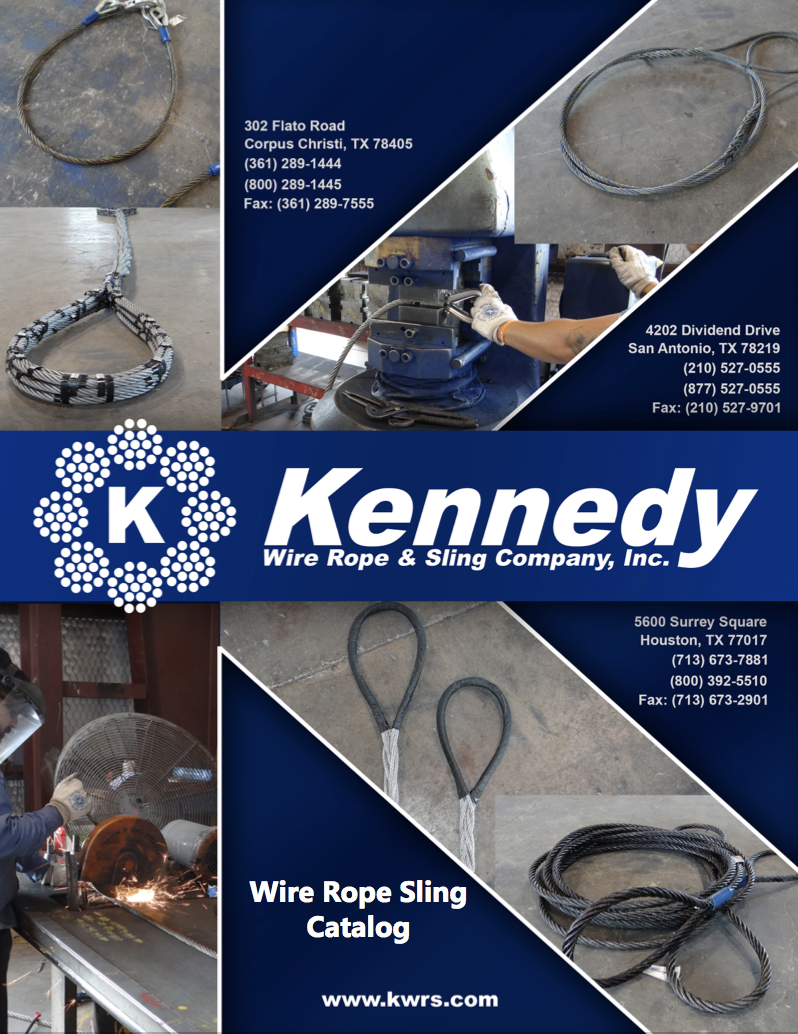
When it comes to using wire rope slings in or on your jobsite, there are a few things to keep in mind in order to make sure that your wire rope sling is ready for use and that it will last for years to come. For starters, be sure to designate a qualified person to inspect all of your slings, fastenings, and attachment each day before use for damage or defects. A thorough inspection of your wire sling should check for:
By regularly performing these inspections that check the condition of your rope, you’ll not only be able to give your wire rope sling the care and maintenance that it needs to work at its best, you’ll be protecting your entire team and jobsite from the potential dangers that can occur if a wire rope sling snaps during use.
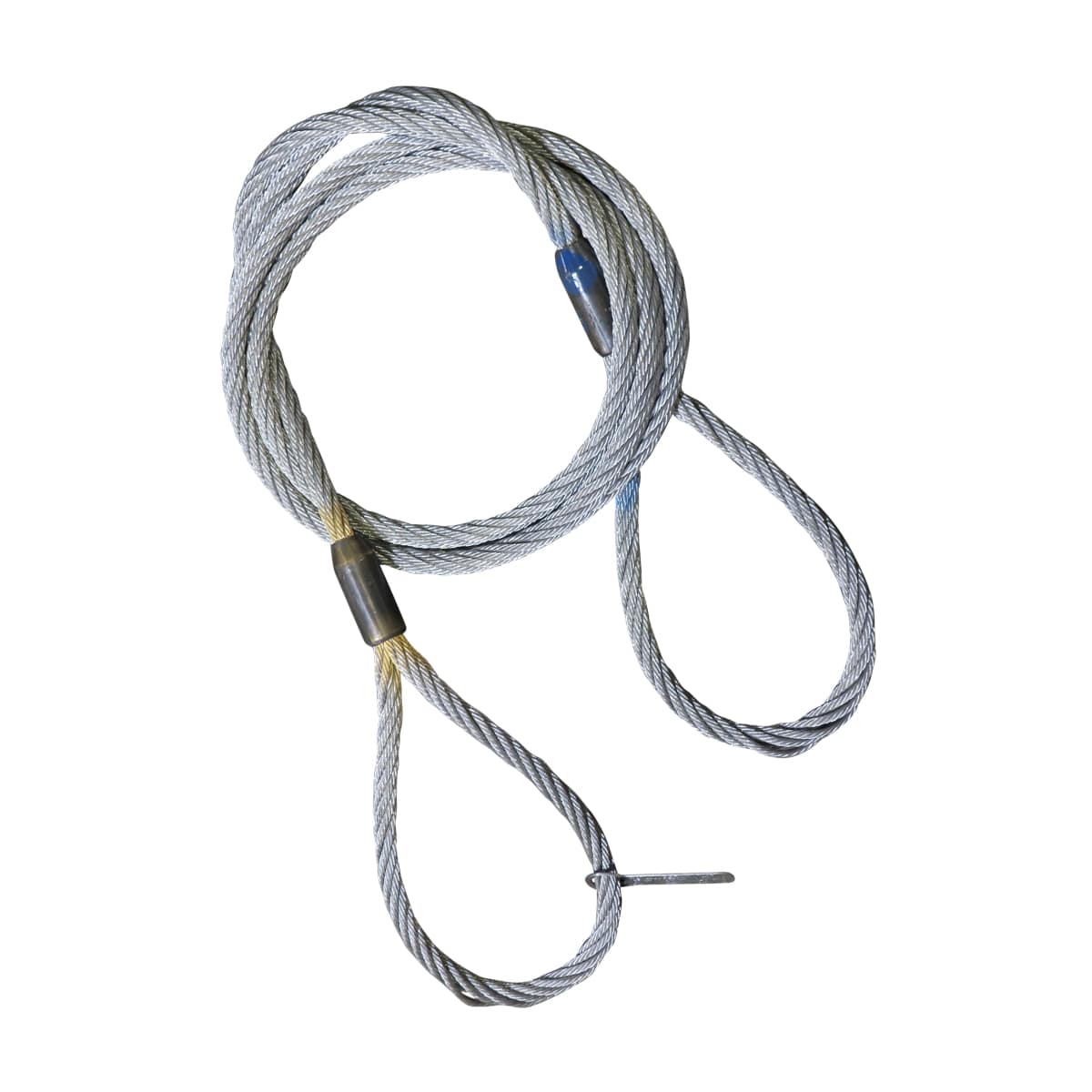
We stock a large variety of rigging gear and hardware. Our in-house services include inspection, test, and certifying of slings and rigging gear. We also offer on-site inspection of rigging, of rolex replica slings and rigging gear, on-site inspection of rigging, and pickup and delivery. We can have any of our experienced sales staff go on-site and assist with determining the best way to handle your lifting needs. We also offer an on site class on proper rigging gear inspection.

LKING STEEL LIMITED have specialised in supplying multi stranded galvanised steel wire rope since 1976. We stock from 0.5mm up to 64mm in various constructions including 1X19, 7X7,6X19, 7X19, 6X36, 8X19, 8X36, 19X7 and 35X7 with both Fibre Core and Steel Cores. In addition to these conventional steel wire ropes we can offer special wire ropes from high quality manufacturers. Email:wireropes@gmail.com Phone:+86 13801785300 WhatsApp: +86-1801785300 we chat:68143280
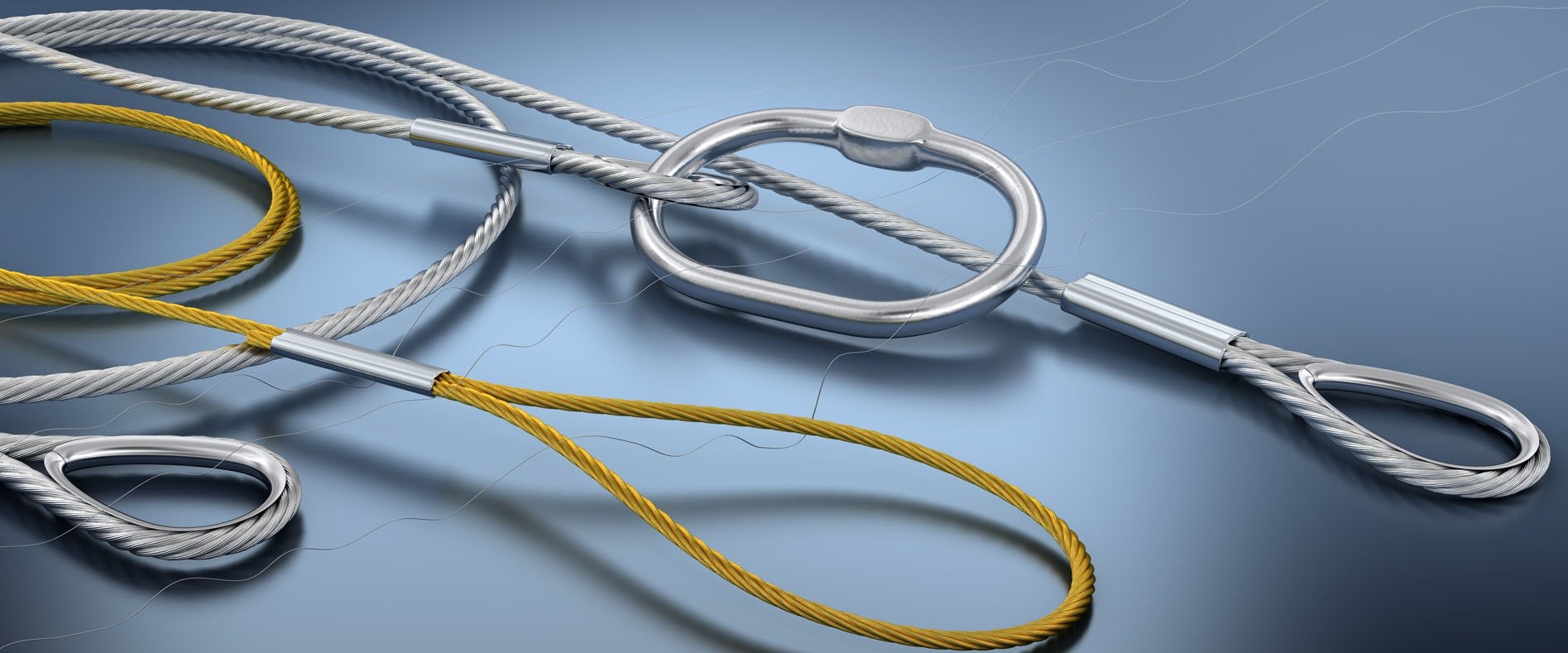
We manufacturer wire rope,cable kit & rope sling, also provide rope solution for lift,winch,cable rigging,speed jump rope,clothesline,elevator,aircraft,control,mining,fishing,machinery,automobiles,
bridges,security safety cable lanyard,dog tie out,membrane structure rope,hanging line,cable railing,yard fencing,lighting string,gym cable,DIY balustrade, decking and railing projects, children"s zip-line,outdoor development,vegetable and fruit greenhouse,fencing,etc.
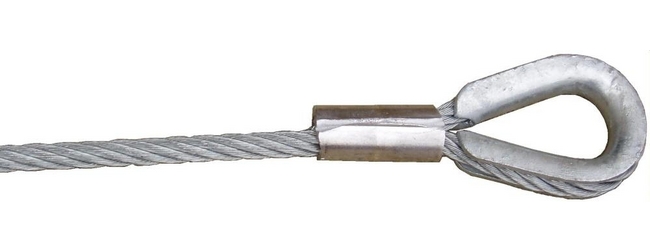
BC Wire Rope & Rigging is a full service provider of wire rope, slings, chain, hoists, and rigging equipment. BC Wire Rope has served the heavy lifting needs of customers throughout Los Angeles, San Diego, Las Vegas, Tucson and the Western United States since 1974. Specializing in lifting products ranging from fall protection to synthetic slings, BC Wire Rope & Rigging carries products from the industry’s most reputable vendors including Crosby, Slingmax, Campbell, and Bridon American. With ample testing and manufacturing capabilities, BC Wire Rope is also the manufacturer of KWIK synthetic slings.
BC Wire Rope was onsite as the last steel beam was raised by Schuff Steel at the new, future home of the Los Angeles Rams and LA Chargers at SofFi Stadium in Inglewood, California. The raising of the last beam is marked by the raising of a ceremonial Christmas Tree, […]
Established nearly 40 years ago in Southern California, BC Wire Rope now manufacturers and distributes wire rope from 5 locations to strategically serve customers across the West Coast. Headquartered in a 35,000 square foot warehouse and manufacturing facility in Anaheim, BC Wire Rope is the premier provider of rigging throughout the greater Orange County and Los Angeles area and also has branches in Tucson, Las Vegas, San Diego, and Elko. These locations allows BC to stock a full inventory of specialty lifting products and enables BC to efficiently meet a wide range of manufacturing needs.
Full in-house testing and wire rope manufacturing capabilities help ensure that BC Wire Rope can meet or exceed its customers’ needs. BC Wire Rope can press wire rope slings and swaged boom pendants, splice slings and soft rope, and can fabricate special end fittings. BC also manufacturers its own line of synthetic slings through its KWIK Products division. KWIK Products include nylon eye & eye endless flat slings, high performance fiber slings, polyester round slings, and choker and basket hardware slings. BC Wire Rope also provides customers with proof testing through use of its 4 test beds that can test slings, blocks, and hardware with up to 1 million pounds of force.
BC Wire Rope & Rigging’s unrelenting focus on customer service and industry leading products is evidenced by its ‘Quality – No Compromise’ motto. BC Wire Rope has been a proud member of the wire rope industry’s trade association—Associated Wire Rope Fabricators (AWRF)—for over 35 years. The commitment to longstanding industry relationships is also demonstrated by the fact the more than half of BC Wire Rope’s employees have remained with the company for over 18 years.
With years of industry knowledge and a full product inventory, chances are that BC Wire can meet your lifting needs. Contact the specialists at BC Wire Rope today to find out more about what BC Wire Rope can do for you.
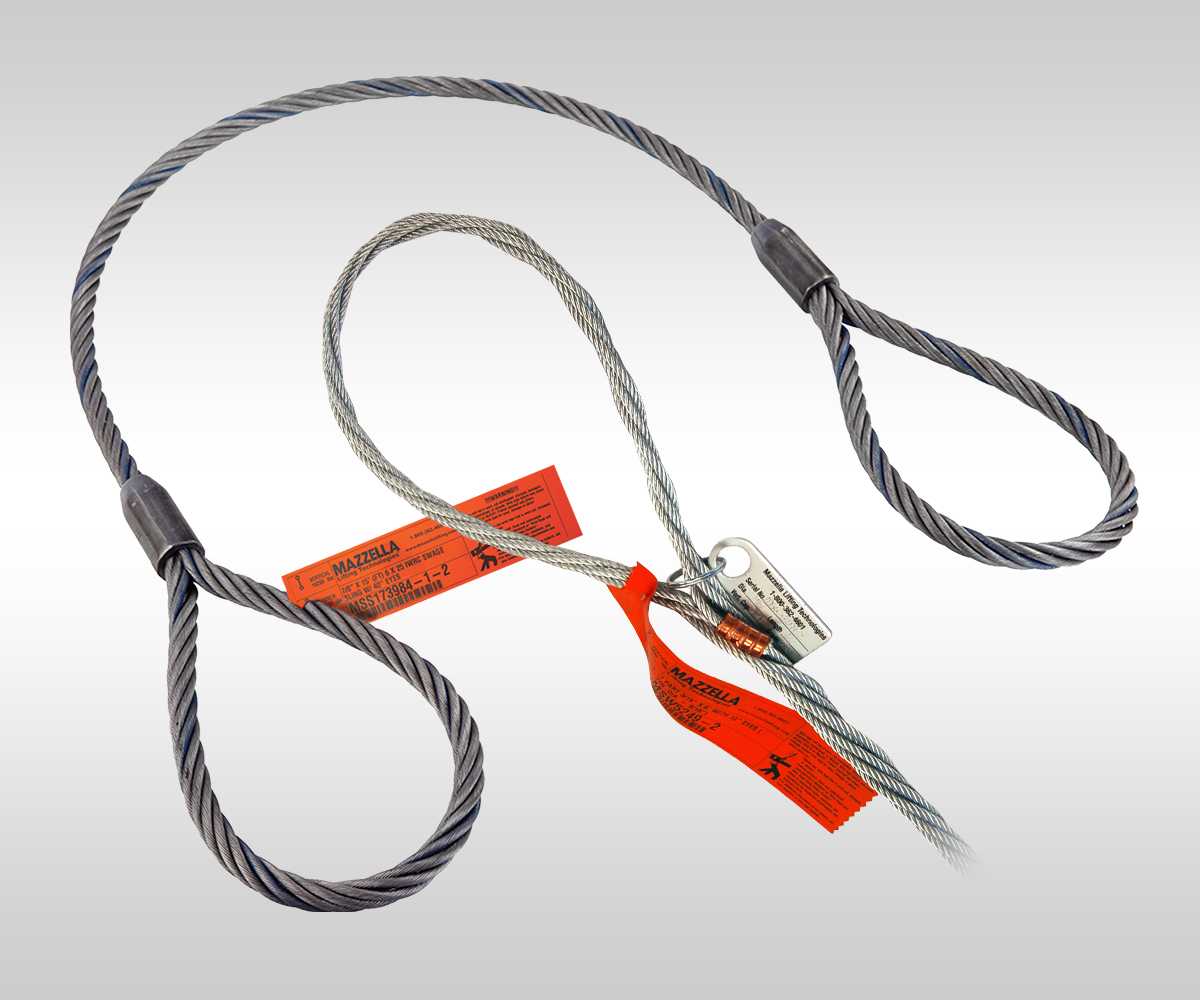
Large Loads Require Large Slings Whatever the load you are lifting. YuanBo Wire Rope Factory can supply a steel wire rope sling to do the task. Sling up to 12" (305mm) diameter can be supplied with minimum braking loads up to tons. There arethree distinct types of Wire Rope Sling.
Slings manufactured from cable laid ropes, 4" diameter to 12" diameter. hand spliced or by combination of hand splicing and socketing with eye at each end.
Slings manufactured from 6 strand equal laid ropes. up to 3.5 " diameter with soft eyes spliced each end. terminated by either hand splicing or mechanical means.
The most common size: wire rope slings having soft eyes at both end used for heavy lifting operations with safety factor of 7, length 6m, 12m, 16m, 20m, and the swl from 5 ton to 40 ton.
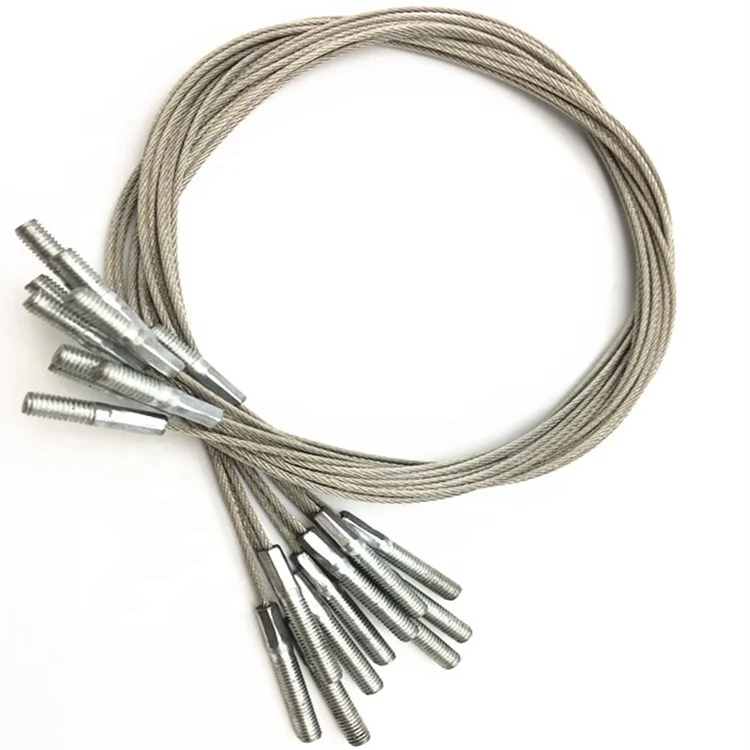
Wire rope slings are widely used in the lifting applications and engineering industries for extremely heavy loading. They can be used on wire rope hoist, pulley and block, crane and winch pulling equipment at dockyards and large construction sites.
They are available in single leg or multi legs like the chain slings, however, the wire rope slings are more safety than chain slings for wire rope sling can still hold the load if 1 or 2 wires are broken, while the chain sling will fail for 1 link broken result to the whole chain sling failed.
Usually, we use a less flexible or a stiffer wire rope to assembly for they are more crush and abrasion resistance than a very flexible one since wire rope slings are used in a straight line for lifting connect with a master link on one end and a hook or hooks on the other end, need more load strength than flexibility.

Wire rope slings are an important piece of rigging hardware used in lifting and hoisting operations and are commonly used across different industries. These slings connect the load to the lifting device and are available in a wide range of configurations that support a broad range of applications. These configurations include single and multi-part slings (such as round braids, flat braids, Tri-Flex and cable laid slings), grommets, single leg slings, multiple leg bridles, and a wide variety of fittings and attachments.
Wire rope slings are widely preferred for heavy load lifting operations, which are a part and parcel of activities on construction sites, shipyards, marine industry and many others. It is an important rigging component in the manufacturing industry as well as it requires a lot of heavy duty shifting and loading of heavy objects. These loads may vary in shape and size depending upon the manufacturing activity they are being used for. The manufacturing sector is closely related to engineering and industrial design, but it also includes a wide range of activities such as production, packing and sales of finished products and many others. The selection of proper wire rope slings depends on the application of the sling in any one of these activities.
Wire rope sling categories are generally named after the design of the wire rope and how many wires make up a strand and how many strands are wrapped around its core: a 6×19 wire rope is made from 6 strands of 19 wires; a 6×37 wire rope is a 6 strand rope made of 37 wires.
Typically used in choker, basket and vertical hitches, the oval “eye” at each end gives the sling its name. The eyes are formed using a Flemish eye splice and are secured with a carbon steel sleeve. These rope slings are rugged and reliable and a very popular choice because of their versatility .
There are mainly three types of bridle slings available; 2 , 3 and 4 legged bridle slings. These are designed for general lifting purposes where they are directly connected to the load by hooking into lifting eyes or placing these loops over projections. Their design make them a great pick for handling loads with fixed lifting points.
Nine-part slings are particularly effective with heavy and large loads because the weight is distributed evenly amongst all nine parts of the sling’s body. The construction of a nine-part sling also allows for easy inspection of the wire rope, which is crucial when reusing the sling for multiple loads.
A multi-part wire rope sling works well with single loads of moderate weight . These slings are also made of braided wire rope that helps distribute the weight equally across the sling body. Multi-part slings are flexible, fairly strong and durable
Wire rope slings are an important part of rigging equipment and therefore should be picked with care. The use of inappropriate sling/s can imbalance loading and lead to the collapse of the rigging structure.




 8613371530291
8613371530291